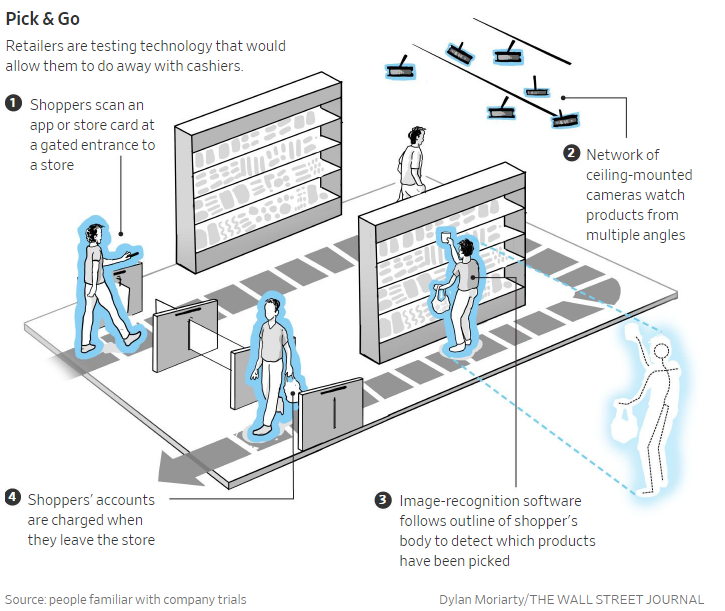|
Cashierless
Stores Make Inroads in U.S.
Sam’s Club,
Giant Eagle and others are exploring the use of AI systems
after Amazon Go paved the way

U.S. retailers large and small are pressing ahead
with testing the use of artificial intelligence to track what products shoppers
pick up and to automatically bill their accounts when they walk out the door,
eliminating the need for checkout lines.
The concept got a push from Amazon Go stores, which
Amazon.com Inc.
launched in early 2018; there are now 15 stores, with two opening last week,
in New York and San Francisco. Amazon Go relies on hundreds of cameras and
sensors in each store to identify products that customers take off the shelves.
Shoppers typically scan a code to enter the stores.

Recent AI adopters include Sam’s Club Inc., the warehouse retailer owned by
Walmart Inc., and Giant
Eagle Inc., a regional chain of grocery and convenience stores. Giant Eagle said
last month that it would test a technology similar to Amazon Go’s at a
convenience store in Pittsburgh, where it is based. Several companies that sell
cashierless technology—including Standard Cognition Inc. and Vcognition
Technologies Inc., which does business as Zippin—said they are working with U.S.
customers but declined to give details.
Sam’s Club plans to offer AI-powered cashierless shopping later this month at a
32,000-square-foot store in Dallas, a quarter of the size of its average store.
Currently, customers shop at the store by scanning barcodes on the products, an
older cashierless-checkout technology. Once the AI system is in place, customers
will use their smartphone cameras to scan the product itself. The cloud-based
system, which uses computer vision and machine learning, recognizes products by
matching them to a database of stored images. This is different from Amazon Go,
where cameras installed in the stores do the work of scanning the products.
Customers at the Sam’s Club store can’t pay using cash at the register, as they
can in certain Amazon Go stores.
A global survey of about 400 retailers conducted in June by research and
advisory firm International Data Corp. found that 28% are testing or piloting
cashierless systems, said Leslie Hand, vice president of IDC’s Retail Insights
division. Ms. Hand said she knows of nearly 100 companies world-wide that are
trying out the systems, adding she can’t discuss the details because of
nondisclosure agreements.
“It’s awoken that fire for retailers to understand that really this is the
future of retail and they need to invest in it,” Ms. Hand said.
Cashierless technology is
being tested by U.K.-based
Tesco PLC and
France-based Carrefour
SA . Tesco has said its method costs a tenth of systems used by its competitors,
partly because it uses only cameras, not sensors.

Not every type of store is suited for cashierless
technology. Walmart tried out a cashierless system based on scanning barcodes
for about six months in more than 100 stores but discontinued it in April 2018.
The technology proved impractical for pricing produce and other items that had
to be taken to a cashier to be weighed, causing delays, a spokesman said.
Theft is also a concern. Manual scanning operates on an honor system and some
customers don’t scan every item, often requiring stores to validate purchases,
said Richard Crone, chief executive of Crone Consulting LLC, an advisory firm
focused on retail, convenience and restaurant businesses. In the Sam’s Club
trial, for example, an employee checks customer purchases as shoppers exit,
though the clerk samples just one product per customer to see if it’s listed on
the electronic receipt.
Still, the potential benefits include speed and convenience. Even small
companies are testing the waters.

Choice Market Holdings LLC, which operates a Denver convenience store focused on
fresh food, plans to open another location next month and is developing three
others. It plans to introduce a cashierless system, using in-store cameras and
sensors, in two of the planned stores next year, said Mike Fogarty, Choice
Market’s founder and CEO.
The company is considering technology providers including AVA retail Inc. for
the project.
“This technology will allow us to extend our hours with little to no labor,
which leads to more transactions,” Mr. Fogarty said.
AVA retail CEO Atul Hirpara said his company’s system virtually eliminates
retail fraud such as price-tag switching, shoplifting and “sweethearting” by
checkout clerks who deliberately don’t charge a customer for a purchase.
Mr. Hirpara said planning, installing and deploying a typical system costs
between $300,000 and $400,000 but the price could rise to $800,000 for a
2,000-square-foot store. Annual maintenance and service costs between $25,000
and $45,000, he said. He said the error rate is one or two per 1,000 purchases.
Mr. Fogarty said Choice Market expects its costs would be at the lower end of
AVA’s estimates because the stores won’t be retrofitted but rather built with
the technology integrated into the design.
Amazon Go’s, AVA’s and other cashierless systems don’t use facial recognition to
identify customers. Instead, the systems track customers’ movements in the store
and link to their online accounts. Sensors installed on store shelves augment
the computer-vision systems by providing data on the weight of items lifted from
shelves to help the AI count the number of items purchased.
Corrections & Amplifications
The Sam’s Club cashierless test store in Dallas doesn’t accept cash payments. An
earlier version of this article said it would accept cash. Also, the store
currently lets customers check out without a cashier by having them scan
barcodes on products; it will introduce an artificial-intelligence system this
month that will allow customers to use their smartphone cameras to scan the
product itself. An earlier version of this article didn’t make it clear the
store is already operating. Sam’s Club announced the AI-powered cashierless
system in March. An earlier version of this article said it was in July. (Aug.
12, 2019)
Article originally published on
wsj.com
|







